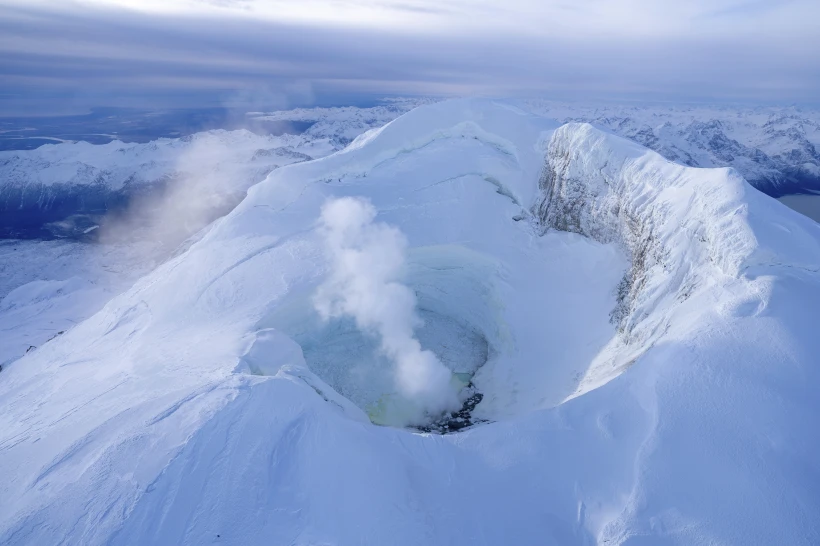Mount Spurr has begun to stir after decades of silence. This 11,070-foot stratovolcano sits 81 miles west of Anchorage, Alaska. For years, it remained quiet—its snow-covered peak barely drawing attention.
But now, scientists are watching closely as the mountain shows signs of a possible volcanic eruption.
The Alaska Volcano Observatory (AVO) has recorded more than 3,400 earthquakes under Mount Spurr in just one year.
Between February and March, over 100 tremors occurred each week. These earthquakes suggest magma is pushing upward beneath the surface.
This isn’t the first time the volcano has made headlines. In 1992, Mount Spurr erupted three times.
The explosions sent ash clouds over Anchorage, disrupted air travel, and caused health problems. The memory of that chaos still lingers for many residents.
Today, Alaskans are preparing once again. They’re buying masks, goggles, and air purifiers. Emergency kits are being packed.
Everyone is listening for updates, waiting to see what the volcano will do next. For now, it’s a tense and uncertain time.
A Surge of Earthquakes Sparks Concern
Mount Spurr’s recent earthquake activity is impossible to ignore. According to AVO scientists, the volcano has produced thousands of tremors over the past year.
This kind of seismic pattern often signals magma movement deep below ground and could lead to a volcano eruption.
Each quake represents stress in the earth’s crust as magma forces its way upward. These quakes vary in size and depth, but together they paint a troubling picture. They match the kind of activity that occurred before the 1992 eruption.

Although the volcano’s alert level remains moderate, monitoring has increased.
Seismometers are capturing ground motion. Scientists are also using satellites to look for changes in the volcano’s shape.
Rising levels of volcanic gases, such as sulfur dioxide, could also indicate an eruption is near. Ariel image of the snow covered Mount Spurr with smoke coming from the center.
Back in 1992, the volcano sent ash more than 12 miles into the sky. Flights were canceled. Ash fell on Anchorage, affecting homes, schools, and businesses. The current pattern of quakes makes experts think a similar volcanic eruption could happen again.
Until then, the region remains in a state of watchful waiting. Researchers continue their 24-hour surveillance, ready to sound the alarm if needed.
Health Risks Loom If Ashfall Returns
Volcanic ash poses serious health risks, especially for people with asthma or breathing issues.
During the 1992 volcano eruption, fine ash particles caused widespread discomfort and illness. These particles are sharp and abrasive, not soft like fireplace soot.
When inhaled, ash can irritate the lungs, nose, throat, and eyes. It can also worsen asthma and other respiratory conditions.
That’s why health experts are urging people to take precautions now, even before an eruption begins.

In response, many residents have stocked up on N95 masks and eye protection. Some are sealing windows and doors. Others are preparing to stay indoors if ash starts falling.
Ash doesn’t just harm people. It can damage cars, clog engines, and contaminate drinking water. It also reduces visibility, which makes driving dangerous.
Local health officials stress that a little preparation can go a long way. Staying indoors, using air filters, and wearing proper gear can make a big difference. With proper planning, many of the worst effects of a volcano eruption can be avoided.
Past Eruptions Offer a Glimpse Into the Future
Mount Spurr’s past eruptions give insight into what could happen next. The volcano erupted in 1953 and again three times in 1992.
Each time, the results were disruptive and dangerous. In 1992, ash clouds reached heights of over 12 miles.
Flights were canceled. Ash fell on Anchorage, affecting homes, schools, and businesses. People were forced to stay indoors and avoid driving.
The volcano’s location adds to the risk. Though it sits across Cook Inlet, strong winds can carry ash across the water. Anchorage, Alaska’s largest city, remains in the danger zone during a volcanic eruption.
Scientists are using data from past eruptions to make predictions. They study the patterns of the ash, seismic data, and gas emissions. Their goal is to understand how the next eruption might unfold.
That past experience is helping the region prepare. While no one can predict the exact timing, the signs are clear. Mount Spurr has done this before—and it can do it again.
Communities Stay Alert While Experts Watch Closely
Alaskans are no strangers to natural hazards. Earthquakes, snowstorms, and wildfires are part of daily life. But when a volcano begins to rumble, people take notice.
Emergency officials are working with scientists to keep the public informed. They’re sharing safety tips and providing real-time updates. Communities are preparing response plans in case of a volcano eruption.
The Alaska Volcano Observatory continues to track every movement. Its team uses tools like gas detectors, cameras, and satellite data. If the volcano changes suddenly, they’re ready to warn the public.
So far, the mood is cautious but calm. Residents are alert but not panicking. Schools and businesses are staying open, but everyone is keeping an eye on the news.
This balance between curiosity and concern defines life near a volcano. People want to understand what’s happening. At the same time, they’re doing what they can to stay safe. As one local said, “When the ground talks, we listen.”
The Calm Before the Eruption?
Mount Spurr may still be silent on the surface, but signs of trouble are building below. With thousands of earthquakes and clear signs of magma activity, scientists believe a volcanic eruption is possible. No one knows exactly when, but the warning signs are hard to miss.
Thanks to modern science and local awareness, Alaska is better prepared than ever. People are listening, and acting early. If Mount Spurr does erupt, it won’t catch them off guard.
Until then, the mountain stands tall, cloaked in snow, with a restless heart below. Whether it erupts tomorrow or next year, one thing is certain—it has our full attention.
